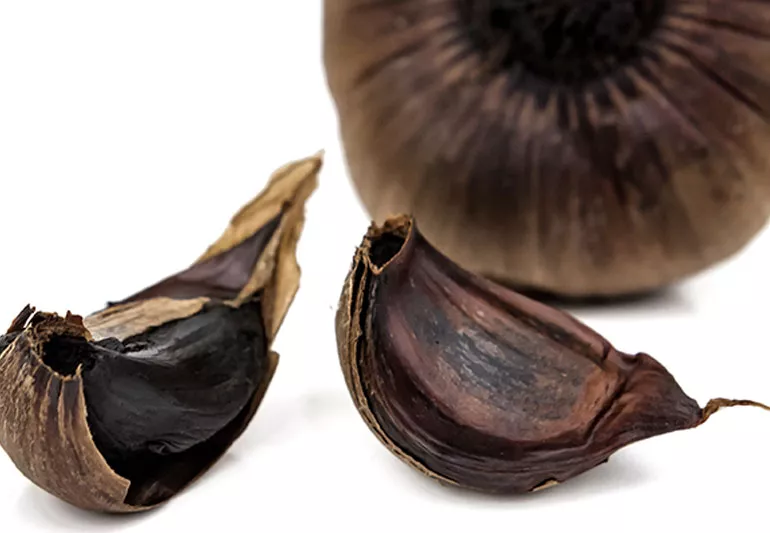Introduction
Black garlic—garlic cloves aged under controlled heat and humidity—has taken the culinary world by storm, prized for its sweet, molasses‑like aroma that bears little resemblance to the sharp, sulfurous bite of fresh garlic. What happens during its transformation is more than just a darkening of color; it’s a chemical symphony of reactions that give rise to hundreds of new aroma compounds and mute the very molecules responsible for raw garlic’s pungency.
The Maillard Reaction: Beyond Brown and Bold
At the heart of black garlic’s sensory metamorphosis lies the Maillard reaction, a non‑enzymatic browning process that occurs when amino acids and reducing sugars interact under heat. Over the typical 30–60 days of aging at around 60–90 °C, these reactants form unstable intermediates that eventually polymerize into melanoidins—brown, high‑molecular‑weight pigments—and a host of volatile organic compounds responsible for the sweet, roasted, and caramel notes in black garlic citeturn0search9.
Taming Sharp Sulfur: From Alliin to S‑Allylcysteine
In fresh garlic, the compound alliin is converted by the enzyme alliinase into allicin when cloves are crushed, generating that characteristic pungent aroma. However, during prolonged heat treatment:
-
Alliin levels plunge, diminishing the pool of precursors for raw garlic’s sharp scent citeturn0search0.
-
Allicin degrades into more stable, water‑soluble sulfur compounds like S‑allylcysteine and S‑allyl‑mercaptocysteine, which possess a much milder, almost sweet garlic character citeturn0search9.
This dual shift—less allicin formation and more S‑allylcysteine accumulation—not only tames harsh volatility but also contributes to black garlic’s touted health benefits.
A Bouquet of New Volatiles: Heterocyclic Compounds Take Center Stage
As Maillard chemistry unfolds, a rich tapestry of heterocyclic volatiles emerges. Gas chromatography–mass spectrometry (GC‑MS) and GC–olfactometry studies have identified over 100 unique aroma compounds in black garlic, spanning:
-
Pyrazines (e.g., 2,3‑dimethylpyrazine) with roasted‑nut and earthy notes
-
Furans (e.g., 5‑methylfurfural, 2‑furanmethanol) imparting caramel, toasted, and fruity accents
-
Thiophenes and pyrroles, which add complexity and depth to the aroma profile citeturn2search1turn2search4.
For instance, 5‑methylfurfural—a furfural derivative—is a hallmark Maillard product whose sweet, almond‑like scent confirms extensive sugar–amino reactions citeturn2search4.
Key Aroma‑Active Compounds: What We Smell and Why
Not all volatiles contribute equally to aroma perception. Aroma extract dilution analysis (AEDA) reveals which compounds have odor activity values (OAVs) above their detection thresholds:
-
Carbon disulfide: provides subtle burnt nuances
-
2‑Methyl‑2‑propanethiol: faintly sulfurous, adding complexity
-
2‑Octanone: green‑fruity undertones
-
4‑Hydroxy‑5‑methyl‑3‑furanone: sweet, caramel‑creme character citeturn2search4.
Together, these high‑impact molecules create the multilayered aroma that chefs and foodies crave.
Cracking the Code: Analytical Techniques
Understanding black garlic’s aroma relies on a suite of precise methods:
-
HS‑SPME‑GC/MS (Headspace Solid‑Phase Microextraction coupled with GC/MS) to profile volatiles without solvent interference
-
GC–Olfactometry, pairing human sniffers with chromatographic separation to pinpoint aroma‑active peaks
-
AEDA, systematically diluting aroma extracts to rank compounds by sensory potency citeturn0search3.
These tools not only map black garlic’s complex volatile landscape but also guide producers in fine‑tuning aging parameters.
Fine‑Tuning Flavor: The Role of Temperature, Humidity, and Time
Small tweaks in processing can shift the aroma balance:
-
Higher temperatures accelerate Maillard reaction rates but risk over‑browning and off‑flavors.
-
Humidity control influences water activity, affecting both reaction pathways and microbial stability.
-
Aging duration determines how far Maillard cascades proceed, from early-stage Strecker aldehydes to late‑stage melanoidins.
Optimizing these factors allows artisanal black garlic makers to dial in specific sensory profiles—ranging from lightly sweet and tangy to deep molasses and balsamic richness.
Conclusion
Black garlic’s captivating aroma is far from accidental. It emerges from the interplay of Maillard chemistry, sulfur‑compound transformation, and the generation of myriad heterocyclic volatiles—all unraveled by cutting‑edge analytical science. As research continues to decode this flavorful enigma, producers and chefs alike gain the power to craft black garlic with precision, ensuring every clove delivers that signature sweet, roasted aroma that has captured kitchens (and noses) around the globe.
Whether you’re a curious foodie or a food scientist, sniffing into black garlic’s secrets reveals how complex chemistry translates into unforgettable flavor.

Comments (0)
No comments yet. Be the first to comment!